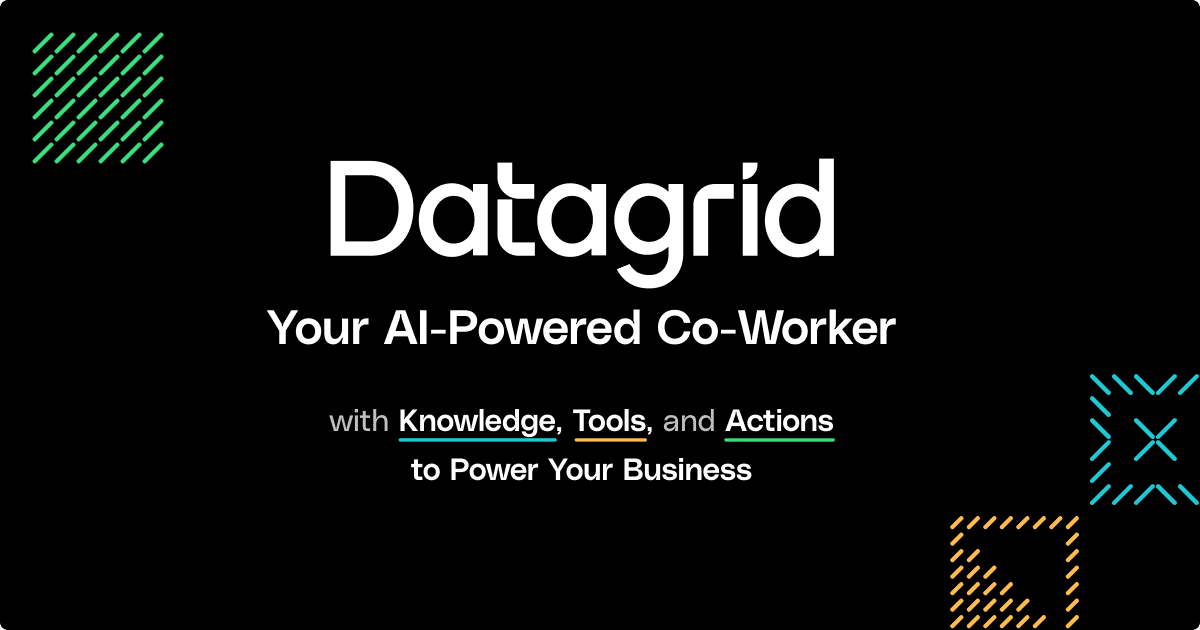All Posts
Productivity tools and techniques
A Complete Guide to Insurance Workflow Automation (With Real Examples)

Revolutionize your insurance processes with our guide to workflow automation. Discover real-world examples, boost efficiency, and unlock new levels of productivity.
Staying ahead of the competition requires addressing a key problem: outdated workflows that inflate operational costs and frustrate both employees and customers. Insurance professionals increasingly need to streamline processes like claims, underwriting, and customer onboarding to reduce errors and boost satisfaction.
Thanks to advanced data connectors from Datagrid, there’s a clear, modern pathway to transform manual tasks into efficient, automated workflows—without overhauling existing systems. In this comprehensive guide, you’ll discover how to automate insurance workflows, evaluate the right technology for automation, and ultimately achieve new levels of profitability and customer engagement.
What is Insurance Workflow Automation?
The insurance industry stands at a critical crossroads, where traditional manual processes are increasingly becoming a liability rather than just an inconvenience. Insurance professionals today face mounting pressure from both operational inefficiencies and evolving customer expectations.
The urgency for automation is underscored by concerning customer satisfaction metrics. Dissatisfaction stems from tedious claim settlements, limited accessibility, and poor communication—all challenges that automation directly addresses.
Modern insurance workflow automation leverages artificial intelligence, machine learning, and robotic process automation to transform core operations. From policy issuance and claims processing to underwriting and customer service, automation creates seamless, efficient workflows that reduce manual intervention while improving accuracy and speed. For insurance professionals looking to modernize their operations, automation offers a clear path to operational excellence and market competitiveness.
The shift toward automation isn't merely about keeping pace—it's about leading in an increasingly digital insurance landscape. As customer expectations continue to evolve and competitive pressures mount, the ability to efficiently process, analyze, and act on information becomes a key differentiator in the market.
Essential Insurance Workflows to Automate
Insurance companies are rapidly embracing automation to streamline operations and enhance customer experience. Let’s explore six core workflows where automation can create a significant impact, supported by real-world implementations and practical guidance.
Automate Customer Onboarding and Policy Issuance
The traditional policy issuance process often involves tedious paperwork and manual data entry, leading to delays and errors. Modern automation solutions transform this experience through digital-first approaches.
Companies like Lemonade have revolutionized this space by implementing AI-driven platforms that enable policy issuance within minutes. Their success demonstrates how automation can dramatically improve customer experience while reducing operational overhead.
To implement effective onboarding automation:
- Integrate optical character recognition (OCR) for automated document processing
- Implement electronic signature capabilities
- Create automated validation checks for application completeness
- Set up automatic data synchronization across systems
Automate Underwriting and Risk Assessment
Manual underwriting processes can be slow and inconsistent. AI-powered automation transforms this crucial workflow by enabling data-driven decisions and faster processing.
Allstate has successfully integrated AI into their underwriting process, using machine learning algorithms to analyze risk factors and predict potential claims. Their approach has significantly improved both the accuracy of risk assessments and processing speed.
Key automation components should include:
- AI-driven analytics platforms for processing multiple data sources
- Automated risk scoring systems
- Integration with external data sources for comprehensive assessment
- Rule-based automated decision making for straightforward cases
Streamline Claims Processing and Management
Claims processing traditionally requires extensive manual review and documentation. Automation can significantly expedite this process while maintaining accuracy.
Progressive Insurance exemplifies successful claims automation through their system that assesses damage via uploaded photos and provides immediate feedback to customers. This automation has substantially reduced claims processing time and improved customer satisfaction.
Essential elements for claims automation:
- AI-powered image analysis for damage assessment
- Automated fraud detection systems
- Integrated workflow management for claims routing
- Real-time status updates for customers
Optimize Policy Renewals and Updates
Policy renewal processes often suffer from inconsistent communication and manual tracking. Automation can transform this into a proactive, efficient workflow.
State Farm demonstrates effective renewal automation through their system of automated communication strategies and online renewal options. This approach has improved customer retention while reducing administrative workload.
Implementation considerations include:
- Automated renewal notification systems
- Integration with CRM platforms like Salesforce
- Personalized communication workflows
- Automated premium calculation systems
Enhance Document Management and Ensure Compliance
Managing insurance documentation manually creates risks of non-compliance and inefficiencies. Automated systems can ensure both accuracy and regulatory compliance, for example by enabling the ability to efficiently extract and analyze data from PDFs.
AXA's implementation of automated document management systems showcases how automation can enhance compliance while improving accessibility. Their system enables real-time tracking of document statuses and ensures up-to-date documentation.
Key components should include:
- Automated document classification and indexing
- Compliance checking algorithms
- Secure storage and retrieval systems
- Automated audit trails
Improve Customer Service and Communication
Traditional customer service approaches often struggle with response times and consistency. AI-powered automation can dramatically improve service delivery.
Geico has successfully implemented AI chatbots that handle policy inquiries and claims status updates, resulting in improved customer satisfaction and reduced call center volumes. Their approach demonstrates how automation can enhance service while maintaining personalization.
Essential elements include:
- AI-powered chatbots for common inquiries
- Automated response systems for routine questions
- Integration with customer data for personalized service
- Seamless escalation to human agents when needed
Each of these workflows represents a significant opportunity for insurance companies to improve efficiency and customer service through automation. Success lies in careful implementation planning, appropriate technology selection, and maintaining a balance between automation and human interaction where needed.
Implementation Best Practices
When implementing insurance workflow automation, success depends on a structured approach that addresses both technical and organizational aspects. Here's how you can ensure a smooth transition to automated processes while maintaining security and compliance.
Identify Automation Opportunities
Start by conducting a thorough assessment of your current workflows to identify the most promising automation candidates. Here's how to approach this:
- Create detailed process maps to visualize your current workflows and identify bottlenecks.
- Use data analytics to evaluate process performance metrics and pinpoint inefficiencies.
- Engage with frontline staff to gather insights about daily operational challenges.
Consider all areas where automation could provide value, such as customer onboarding, claims processing, or even internal processes like responding to RFPs. For example, you can automate the RFP response process using AI to streamline proposal generation and increase efficiency.
When prioritizing processes for automation, consider:
- Impact potential (time savings, cost reduction, customer satisfaction)
- Implementation complexity versus expected benefits
- Transaction volume and repetition frequency
Select the Right Technology Stack
The success of your automation initiative heavily depends on choosing appropriate technologies. Consider these key factors:
- Scalability to accommodate future growth and additional automation needs
- Integration capabilities with your existing systems through APIs or pre-built connectors
- User-friendliness to minimize training requirements and maximize adoption
Your technology stack should include:
- Robotic Process Automation (RPA) tools for handling repetitive tasks
- Document Management Systems (DMS) for streamlining document handling
- AI and ML platforms for enhancing customer interactions and data analysis
Prioritize Security and Compliance
In the highly regulated insurance industry, security and compliance must be at the forefront of your automation strategy. Implement these essential measures:
- Data encryption for both in-transit and at-rest information
- Role-based access controls to ensure appropriate data access
- Regular security audits and vulnerability assessments
Ensure compliance with key regulations:
- GDPR for data privacy and protection
- HIPAA for protected health information
- NAIC guidelines for insurance industry standards
Create a compliance calendar and integrate automated compliance checks into your workflows to maintain continuous adherence to regulations.
Manage Change and Provide Training
According to research, 88% of small and medium-sized businesses believe automation helps them compete with larger companies. However, realizing these benefits requires effective change management:
- Communication Strategy:
- Clearly explain automation benefits to all stakeholders.
- Maintain transparent communication about implementation timelines.
- Address concerns proactively.
- Implementation Approach:
- Start with pilot projects to validate effectiveness.
- Use a phased rollout to minimize disruption.
- Gather and incorporate feedback throughout the process.
- Training Program:
- Develop role-specific training materials.
- Provide hands-on practice sessions.
- Establish a continuous learning environment.
Remember to monitor the effectiveness of your implementation through:
- Regular performance assessments
- User feedback collection
- Process optimization based on metrics and insights
By following these implementation best practices, you can ensure a successful transition to automated workflows while maintaining security, compliance, and employee engagement. The key is to approach the implementation systematically, with careful attention to both technical and human factors.
Leveraging AI for Enhanced Automation
The insurance industry is experiencing a fundamental transformation through artificial intelligence, shifting from traditional "detect and repair" approaches to more sophisticated "predict and prevent" strategies. This transformation is driven by innovations in AI agent architectures, which enable more advanced predictive and preventative measures.
Use AI-Powered Document Processing
One of the most impactful applications of AI in insurance is automated document processing. Natural Language Processing (NLP) and machine learning technologies now handle the complex task of extracting and analyzing data from various insurance documents, including claims forms, policy applications, and underwriting reports.
For example, platforms like WorkFusion leverage AI and machine learning to analyze documents and automate policy data intake, significantly reducing the manual effort required for policy endorsements. This automation not only accelerates processing times but also ensures higher accuracy and better compliance with regulatory standards.
Implement Automated Risk Assessment
AI is revolutionizing risk assessment through sophisticated data analysis capabilities. Using advanced machine learning models and AI agent architectures, systems now evaluate vast datasets, including historical claims data, customer behavior patterns, and external factors, to predict future claims and inform underwriting decisions with unprecedented accuracy.
Companies like Lemonade demonstrate the power of AI-driven underwriting, using real-time risk assessment to offer dynamic pricing and personalized policy offerings. These systems continuously learn from new data, improving their predictive capabilities and adapting to evolving risks from factors like climate change or economic shifts.
Provide Intelligent Customer Service
AI-powered customer service represents another breakthrough in insurance automation. Virtual assistants and chatbots now provide 24/7 support, handling everything from basic inquiries to complex claims processing.
For instance, Allstate's virtual assistant "ABIE" helps customers with policy management and claims processing, demonstrating how AI can enhance customer satisfaction while reducing operational costs.
Such AI solutions analyze customer interactions to identify common issues and continuously improve service delivery. By automating routine inquiries, insurance companies can redirect human agents to handle more complex cases that require personal attention, creating a more efficient and satisfying customer experience, leveraging advanced AI techniques.
Measuring Success and ROI
To effectively evaluate the impact of insurance workflow automation initiatives, organizations need a comprehensive framework that combines both quantitative metrics and qualitative assessments. Here's how to measure success and calculate ROI for your automation investments.
Track Key Performance Indicators
Start by tracking these essential KPIs to measure the effectiveness of your automation implementation:
- Processing Time Reduction: Monitor the decrease in time required for core insurance processes. According to industry studies, AI-supported automation can accelerate quote submissions and claim decisions by up to 12 times faster, while document processing can become 50 times quicker.
- Operational Cost Savings: Track direct cost reductions from automated processes. Insurance companies typically see a 10-25% decrease in operational expenses through basic automation, with AI-powered solutions potentially delivering 30-50% cost reductions.
- Team Productivity Metrics: Measure the impact on staff efficiency. Successful automation implementations have shown up to a 50% reduction in employee workload alongside a 25-35% increase in team productivity.
- Error Rate Reduction: Monitor the decrease in processing errors, which directly impacts customer satisfaction and compliance costs.
Leverage ROI Calculation Methods
Calculate the return on your automation investment using both quantitative and qualitative approaches:
Quantitative Assessment:
- Calculate the total cost of ownership (TCO), including implementation, maintenance, and training costs.
- Measure direct cost savings from reduced manual processing.
- Track revenue improvements from faster processing and increased capacity.
- Monitor resource reallocation benefits.
Qualitative Benefits:
- Customer satisfaction improvements.
- Enhanced employee satisfaction from reduced manual tasks.
- Better compliance and risk management.
- Improved data accuracy and decision-making capabilities.
For example, if implementing an automation solution costs $200,000, you can calculate ROI by comparing it against the combined benefits of operational cost savings (10-25%), productivity increases (25-35%), and error reduction. Include both immediate savings and long-term benefits in your calculations.
When measuring ROI, consider creating a balanced scorecard that weighs both financial metrics and operational improvements. This approach provides a more complete picture of the automation initiative's success and helps justify future investments in automation technology.
Remember to establish baseline measurements before implementation and track progress regularly. This data-driven approach will help you identify areas for optimization and demonstrate the concrete value of your automation initiatives to stakeholders.
How Agentic AI Simplifies Insurance Workflow Automation
Datagrid enhances productivity and saves time across various industries by leveraging AI agents and automation to streamline workflows and reduce manual tasks. Here's how Datagrid's technology contributes to increased efficiency:
- Automated Data Enrichment - Datagrid's AI agents can automatically enrich datasets, eliminating the need for manual data entry and research. This allows teams to focus on high-value activities instead of spending time on tedious data gathering tasks.
- Intelligent Task Execution - The platform enables AI agents to execute tasks autonomously, such as drafting responses to RFIs, analyzing long PDFs, or creating personalized outreach emails. This automation significantly reduces the time spent on repetitive tasks across departments.
- Seamless Integration - Datagrid connects with over 100 apps and tools, creating an integrated ecosystem where information flows seamlessly between platforms. This integration eliminates the need for manual data transfer and reduces the risk of errors.
- Automated Reporting and Analytics - AI agents can generate regular reports and analyze data from various sources, providing insights without requiring manual compilation. This feature is particularly useful for managers who need up-to-date information for decision-making.
- Streamlined Communication - The platform automates communication processes by sending personalized notifications, reminders, and updates across various channels like email, Slack, and Microsoft Teams. This ensures that all team members stay informed without constant manual follow-ups.
By implementing Datagrid's AI-powered solutions, organizations can significantly reduce time spent on administrative tasks, allowing employees to concentrate on strategic activities that drive business growth and innovation.
The platform's ability to handle complex data operations and automate workflows makes it a valuable tool for enhancing productivity across diverse industries.
Simplify Insurance Workflow Automation with Agentic AI
Ready to revolutionize your insurance operations? Datagrid delivers AI-powered solutions to enhance workflow efficiency with:
- Seamless integration across 100+ insurance platforms
- AI-driven workflow automation that reduces administrative tasks by up to 30%
- Intelligent task management and error reduction
- Real-time insights and personalized customer experiences
- End-to-end process automation for claims, underwriting, and policy management
Create a free Datagrid account and transform your insurance workflows with cutting-edge AI automation.












